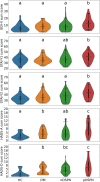Risk factors for depression and anxiety in painful and painless diabetic polyneuropathy: A multicentre observational cross-sectional study
- PMID: 34592017
- PMCID: PMC9293147
- DOI: 10.1002/ejp.1865
Risk factors for depression and anxiety in painful and painless diabetic polyneuropathy: A multicentre observational cross-sectional study
Abstract
Background: Despite the high prevalence of depression and anxiety in chronic pain conditions, current knowledge concerning emotional distress among painful diabetic polyneuropathy (pDSPN) and other diabetes mellitus (DM) sufferers is limited.
Methods: This observational multicentre cohort study employed the Hospital Anxiety and Depression Scale, the Beck Depression Inventory II and the State-Trait Anxiety Inventory to assess symptoms of depression and anxiety in several groups with diabetes, as well as in a control group. The study cohort included 347 pDSPN patients aged 63.4 years (median), 55.9% males; 311 pain-free diabetic polyneuropathy (nDSPN) patients aged 63.7 years, 57.9% males; 50 diabetes mellitus (DM) patients without polyneuropathy aged 61.5 years, 44.0% males; and 71 healthy controls (HC) aged 63.0 years, 42.3% males. The roles played in emotional distress were explored in terms of the biological, the clinical (diabetes-, neuropathy- and pain-related), the socio-economic and the cognitive factors (catastrophizing).
Results: The study disclosed a significantly higher prevalence of the symptoms of depression and anxiety not only in pDSPN (46.7% and 60.7%, respectively), but also in patients with nDSPN (24.4% and 44.4%) and DM without polyneuropathy (22.0% and 30.0%) compared with HCs (7.0% and 14.1%, p < 0.001). Multiple regression analysis demonstrated the severity of pain and neuropathy, catastrophic thinking, type 2 DM, lower age and female sex as independent contributors to depression and anxiety.
Conclusions: In addition to the severity of neuropathic pain and its cognitive processing, the severity of diabetic polyneuropathy and demographic factors are key independent contributors to emotional distress in diabetic individuals.
Significance: In large cohorts of well-defined painless and painful diabetic polyneuropathy patients and diabetic subjects without polyneuropathy, we found a high prevalence of the symptoms of depression and anxiety, mainly in painful individuals. We have confirmed neuropathic pain, its severity and cognitive processing (pain catastrophizing) as dominant risk factors for depression and anxiety. Furthermore, some demographic factors (lower age, female sex), type 2 diabetes mellitus and severity of diabetic polyneuropathy were newly identified as important contributors to emotional distress independent of pain.
© 2021 The Authors. European Journal of Pain published by John Wiley & Sons Ltd on behalf of European Pain Federation - EFIC ®.
Conflict of interest statement
None of the authors has any conflict of interest to declare.
Figures


References
-
- Aslam, A. , Singh, J. , & Rajbhandari, S. M. (2014). The impact of painful diabetic neuropathy on quality of life: An observational study. Diabetes & Primary Care, 16, 212–219.
-
- Bai, J.‐W. , Lovblom, L. E. , Cardinez, M. , Weisman, A. , Farooqi, M. A. , Halpern, E. M. , Boulet, G. , Eldelekli, D. , Lovshin, J. A. , Lytvyn, Y. , Keenan, H. A. , Brent, M. H. , Paul, N. , Bril, V. , Cherney, D. Z. I. , & Perkins, B. A. (2017). Neuropathy and presence of emotional distress and depression in longstanding diabetes: Results from the Canadian study of longevity in type 1 diabetes. Journal of Diabetes and Its Complications, 31, 1318–1324. 10.1016/j.jdiacomp.2017.05.002 - DOI - PubMed
-
- Beck, A. T. , Steer, R. A. , & Brown, G. K. (1996). BDI‐II: Manual for the beck depression inventory (2nd ed.). Psychological Corporation.
Publication types
MeSH terms
LinkOut - more resources
Full Text Sources
Medical

